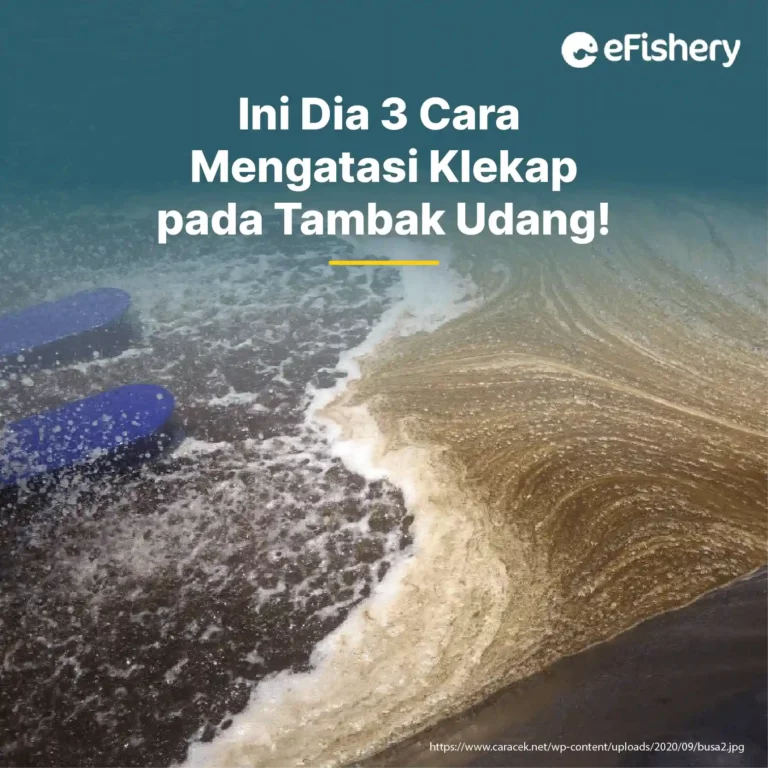Artikel Ini Telah Direview Oleh:

Anggie Nur
Magister Bioteknologi
Farmers must know how to deal with klekap in shrimp ponds. If it is not immediately cleaned from the shrimp ponds, the klekap will rot at the bottom of the pond pond. It is this decomposition process that will contaminate the pond, damage the quality of pond water and cause death in your shrimp culture.
The increase in valves in ponds is caused by the accumulation of organic matter in pond waters. Check out an explanation of the causes, dangers, and how to deal with a complete clamp in the following article!
Klekap on Shrimp Ponds
Klekap is a woven-shaped algae attached to one another. Klekap has greenish-brown to bluish-green sheets, depending on the structure of the algae. The composition of the clamp consists of the types of algae Oscillatoria sp., Rhizosolenia sp., And Pleurosigma sp..
The formation of klekap starts from dead plankton at the bottom of the pond mixed with shrimp feces. This mixture is then lifted to the surface of the pond waters due to the oxidation process. The klekap oxidation process starts from the high intensity of sunlight that hits the bottom of the pond and lifts the klekap from the bottom of the pond to the surface of the pond.
Are Claps Dangerous?
The presence of klekap in intensive shrimp pond cultivation can cause high organic matter and decreased oxygen content due to the degradation of organic matter. If the klekap on the surface of the shrimp pond is not removed, the klekap will fall back to the bottom of the pond and rot.
The valve decomposition process will produce ammonia and hydrogen sulfide gas bubbles which cause the appearance of a foul odor in the sludge at the bottom of the pond pond. This is what you must pay attention to so that big problems do not occur in shrimp farming, such as mass mortality.
How to Overcome the Appearance of Klekap in Shrimp Ponds
How to deal with klekap in shrimp ponds is relatively easy, namely by lifting the klekap, then applying urea and TSP fertilizer. The following is a description of how to deal with klekap in shrimp ponds:
- Lift the clamp that is on the surface of the pond water
- Clean the bottom of the pond by circulating water continuously and by siphoning (removing dirt on the bottom of the pond)
- Restore good pond water quality by placing plankton seeds in pond ponds through fertilization, at a dose of 1,500-2,000 kg/ha
Overcome Klekap Early on with the Right Steps from the Experts at eFarm!
Good fertilization can prevent excessive klekap arising while maintaining the balance of the pond. If you want to know more about klekap and how to handle it according to your shrimp pond, you can consult directly with an aquaculture expert through the feature Cultivation Consultation in eFarm.
Need Help Regarding Shrimp Cultivation Business?
Fill in your personal data in the following form. Our team will immediately contact you via the number cellphone attached. Make sure the data entered is correct.
eFarm is an application made specifically for shrimp farmers. This application provides various solutions for your cultivation problems. One of them is features Cultivation Consultation, where you can chat and consult with aquaculture experts about the shrimp farming business, from consulting on dealing with klekap, maintaining pond water quality, preventing shrimp disease, to feed management.
Don't wait until the problem gets worse, immediately consult an Aquaculture expert so that you can get the right and fast solution. Have eFarm now, it's free!

Anggie Nur - Magister Bioteknologi
Anggie merupakan lulusan sarjana dan magister bioteknologi serta memiliki pengalaman riset di dunia perikanan khususnya udang
Questions About How to Overcome Klekap in Shrimp Ponds
Klekap is a woven-shaped algae attached to one another. Klekap is made from dead plankton that settles at the bottom of the pond and mixes with shrimp feces. Klekap has greenish-brown to bluish-green sheets, depending on the structure of the algae. The composition of the clamp consists of the types of algae Oscillatoria sp., Rhizosolenia sp., And Pleurosigma sp.
The presence of klekap in intensive shrimp pond cultivation can cause high organic matter and decreased oxygen content due to the degradation of organic matter. If the klekap on the surface of the shrimp pond is not removed, the klekap will fall back to the bottom of the pond and rot. The valve decomposition process will produce ammonia and hydrogen sulfide gas bubbles which cause the appearance of a foul odor in the sludge at the bottom of the pond pond.
- Gunarto and Mansyur A. 2007. Vannamei Shrimp (Litopenaeus Vannamei) Cultivation in Ponds with Different Stocking Densities Using a Supplementary Fertilization System. J. Ris. I am a. Vol. 2(1):167-176.
- Juliana, Melani WR, Kurniawan. 2019. Post-Mining Tin Lake Fertility Level in Prayun Village, Kundur District, Karimun Regency. Sustainable Aquatic Journal. Vol. 3(1):18-22.
- Poernomo A. 2004. Probiotic technology to overcome the problems of shrimp ponds and the cultivation environment. Paper Presented at the National Symposium on the Development of Science and Technology Innovation in Aquaculture. Semarang.
